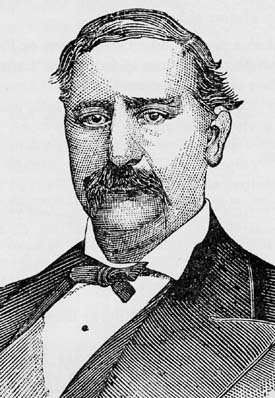
| Home | Information | Contents | Search | Links |
 |
Nathan Dane Urner, journalist and writer, was born in Cincinnati, Ohio, January 12, 1839,(1) and was educated in public and private schools of that city. At the age of twelve he was already ambitious to become a newspaperman, and published the Queen City Gem, a one-copy weekly, composed and written out by hand and passed from hand to hand at one cent per reader. When he was fifteen years of age he stopped school and for two years worked in stores in Cincinnati and St. Louis, then went "out West," where he drove ox and mule teams for two more years in Kansas, New Mexico, and Chihuahua. He then began contributing to various periodicals. In 1862 he became private secretary to Horace Greeley, working for him in the compilation of the first volume of "The Great American Conflict." The next year he became a reporter on the New York Tribune, and as a result of a "highly imaginative" account of the destruction of P. T. Barnum's American Museum, July 13, 1865,—a description widely copied and later used by Barnum in his advertisements-was made city editor of that paper. He held this position only a short time, resigning to go to the west coast of South America as a sort of roving correspondent for the same paper.
Returning to the United States a year later, he became a free-lance writer, although at the same time he had some sort of loose connection with various weekly story papers in New York and Boston, and wrote many novels and serials.
Urner was twice married; first to Annie Rizer and in 1891 to Marie Faehnlin. He died February 19, 1893, at St. Luke's Hospital, in Brooklyn, and was buried in Greenwood Cemetery.
For the weekly story papers and the various "libraries" he wrote under his own name as well as under the name "Burke Brentford."(2) Street & Smith believe that he used other pen names in stories written for them, but if so they are now unknown, since no record was kept and the last man who had knowledge of such things has been dead for over twenty years. "Mentor" is given by Allibone as an early pseudonym. Miller(3) assigned to him the names Burke Brentford, Ingoldsby North, Septimus R. Urban, Bartley Campbell, Edward Minturn, Prof. Gildersleeve, and Bryant Bainbridge—all Beadle authors—as well as Maurice Silingsby, Clarence Clancool, and Carl Courteney. I have made no attempt to verify the latter group, but of the names listed as Beadle authors, Urban belonged to Rymer, Edward Minturn belonged to Judson, and Campbell was a well-known actor. North, Gildersleeve, and Bainbridge I have not been able to identify.
Urner's personal appearance was thus described in the New York Evening Sun:(4)
Tall, tipping the scales at 250 pounds, carrying a nose of Hebraic proportions and a mustache of intense blackness, Nathan Dane Urner, manufacturer of verse and constructor of serials, walks the pave with his eyes constantly fixed on a spot on the sidewalk about three yards in advance of his footsteps.
And in a poem, "The Ghost Poets of Printing House Square,"(5) he was spoken of as "Urner—big Nat— bon vivant to the core."
REFERENCES: Allibone, Supplement, II. New York Evening Sun, op. cit., in footnote; The Journalist, II, March 28, 1885, 1; October 17, 1885, 1; IV, August 7, 1886; November 27, 1886, 6; V, September 17, 1887, 11; VI, March 10, 1888, 12; XII, November 22, 1890, 2; XVI, February 25, 1893, 4; Banner Weekly, XI, No. 542, April 1, 1893; New York Tribune, February 22, 1893 (announcement of death); letters from Urner's sister-in-law, Mrs. Charles A. Urner, 1941.
Under the pseudonym "Burke Brentford" were published:
Banner Weekly. Nos. 327, 350, 362, 401, 413
Dime Library. Nos. 846, 866, 878, 889, 919
Notes
| 1 | The date of his birth so given in a letter from Mrs. Charles A. Urner, June 9, 1941. |
| 2 | Data from Street & Smith, in litteris, June 5, 1941. See also in this book under "Burke Brentford." |
| 3 | W. C. Miller, Dime Novel Authors, Grafton, Mass., 1933. |
| 4 | Reprinted from the Sun article, "Poets on the Pave," by The Journalist, VI, March 10, 1888, 12. |
| 5 | Town Topics, reprinted in The Journalist, XXI, July 24, 1897, 107. |